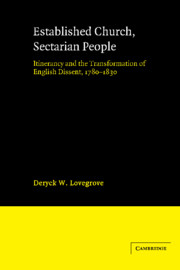 Established Church, Sectarian People
Established Church, Sectarian People Book contents
- Frontmatter
- Contents
- List of figures
- Preface
- Acknowledgements
- List of abbreviations
- 1 The Established Church and English Separatism
- 2 Itinerancy and Dissent
- 3 Preachers and sponsors
- 4 The academic leaven
- 5 Organization and infrastructure
- 6 Support and opposition
- 7 Criticism and legality
- 8 Developments and trends
- Conclusion
- Appendix A Journal of T[homas] Wastfield, June 1797–April 1798
- Appendix B Organizations active in itinerant evangelism
- Appendix C Baptismal statistics
- Notes
- Bibliography
- Index
1 - The Established Church and English Separatism
Published online by Cambridge University Press: 13 October 2009
- Frontmatter
- Contents
- List of figures
- Preface
- Acknowledgements
- List of abbreviations
- 1 The Established Church and English Separatism
- 2 Itinerancy and Dissent
- 3 Preachers and sponsors
- 4 The academic leaven
- 5 Organization and infrastructure
- 6 Support and opposition
- 7 Criticism and legality
- 8 Developments and trends
- Conclusion
- Appendix A Journal of T[homas] Wastfield, June 1797–April 1798
- Appendix B Organizations active in itinerant evangelism
- Appendix C Baptismal statistics
- Notes
- Bibliography
- Index
Summary
In May 1660 an important declaration of religious intent by Charles II, king in exile, then at Breda in the Netherlands, was read to the assembled members of the English Parliament. In the most famous passage of the declaration the king acknowledged the divided state of religious opinion within the country and expressed the conviction that free discussion would resolve many of the differences: ‘… we do declare’, he wrote, ‘a liberty to tender consciences, and that no man shall be disquieted or called in question for differences of opinion in matter of religion, which do not disturb the peace of the kingdom’. Already more than a century had elapsed since the acceptance of Protestantism, and in the intervening years, as the declaration noted, a bewildering range of belief had surfaced in English society offering religious alternatives which seemed increasingly to challenge the basic pretensions of the national church.
The English version of the Reformation, which reappeared after the unsettled years of Mary Tudor, was conservative in its approach to theology and worship, territorial in organization and, above all, monopolistic in its claims upon the religious allegiance of the nation. The reformed Church of England remained the only recognized ecclesiastical body within the realm. Like the majority of European leaders in the sixteenth century, English monarchs, ministers and ecclesiastical dignitaries accepted without question the idea of a single, undivided Church coterminous with civil society.
- Type
- Chapter
- Information
- Established Church, Sectarian PeopleItinerancy and the Transformation of English Dissent, 1780–1830, pp. 1 - 13Publisher: Cambridge University PressPrint publication year: 1988


